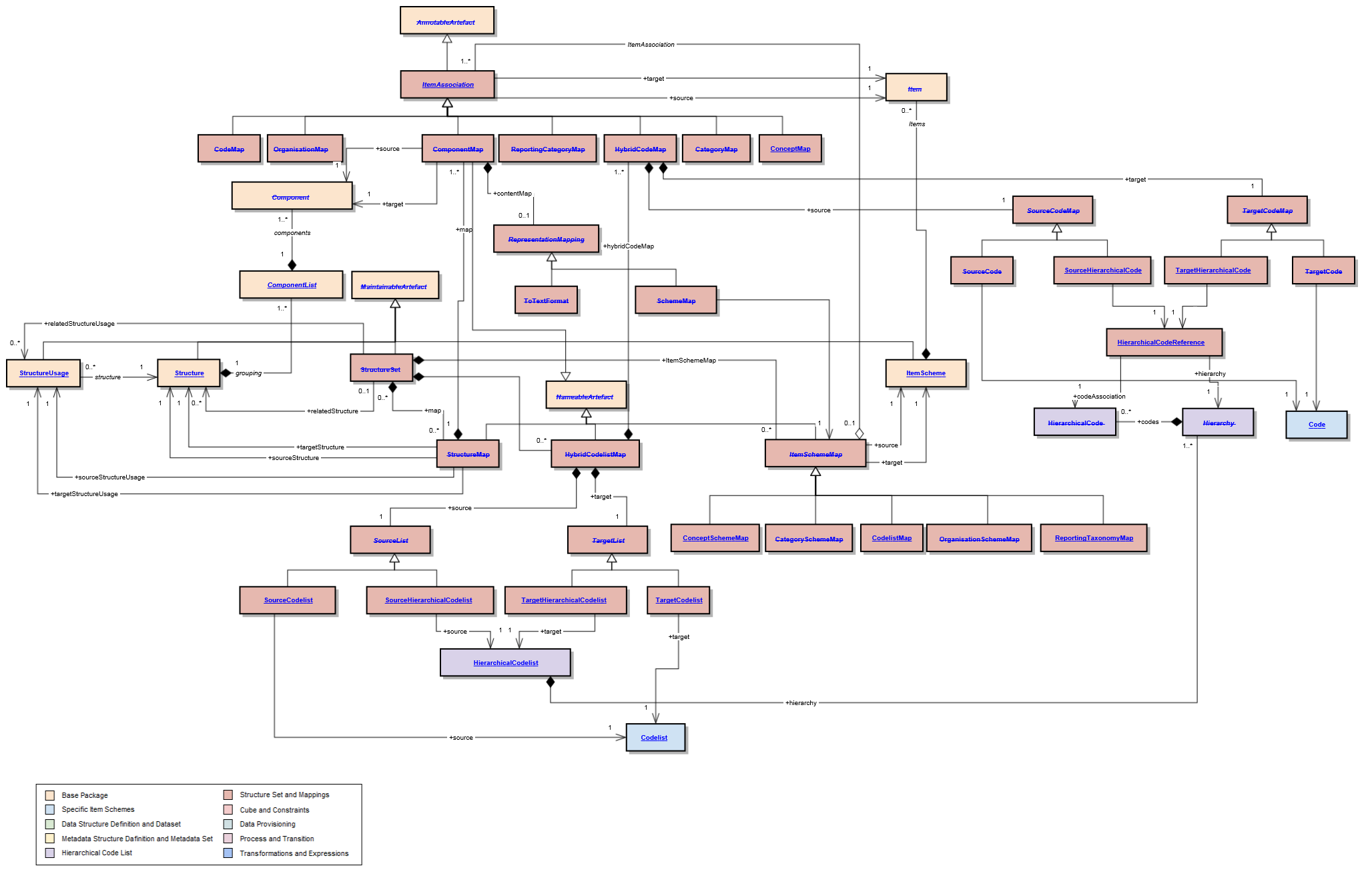Login required to access some wiki spaces. Please register to create your login credentials
|

Explanation of the diagram
A StructureSet allows components in one structure to be mapped to components in another structure of the same type. In this context the term “structure” is used loosely to include types of ItemScheme, types of Structure, and types of StructureUsage. The allowable structures that can be mapped, and the components that can be mapped within these structures are:
| Structure Type | Component type |
|---|---|
| Codelist | Code |
| Category Scheme | Category |
| Concept Scheme | Concept |
| Organisation Scheme Organisation | this allows mapping any type of Organisation to any type of Organisation (e.g. a Data Provider to an Organisation Unit) |
| Hierarchical Codelist | Hierachical Code to Code or vice-versa |
| Data Structure Definition | Dimension, Measure Dimension, Time Dimension. Data Attribute, Primary Measure |
| Metadata Structure Definition | Target Object, Metadata Attribute |
| Dataflow Definition | None |
| Metadataflow Definition | None |
The StructureSet can contain one or more “maps” and can define related structures (via the association +relatedStructure) which group related DataStructureDefinitions, MetadataStructureDefinitions, DataflowDefinintions, MetadataflowDefinintions.
The StructureSet can contain:
- A set of references to concrete sub-classes of Structure and StructureUsage (DataStructureDefinition, MetadataStructureDefinition, DataflowDefinition or MetadataflowDefinition) to indicate that a relationship exists between them. For example there may be a group of DataStructureDefinition which, together, form the definition of a cube, each DataStructureDefinition defining a part of the cube.
- A set of StructureMaps which define which components of one structure are equivalent to those in another in a ComponentMap.
- A set of ItemSchemeMaps which define the mapping between two concrete classes of ItemScheme, and the mapping of the Items in these schemes, such as the mapping of Codes in two Codelists..
- A set of HybridCodelistMaps which define the mapping between a Codelist and a HierachicalCodelist.
- The StructureMap references two Structures or StructureUsages. In concrete terms these references will be to DataStructureDefinitions, MetadataStructureDefinitions, DataflowDefinitions or MetadataflowDefinitions.
The StructureMap contains a set of ComponentMaps, each one indicating equivalence between Components of the referenced Structure. ComponentMap has a RepresentationMapping which can be one of the concete classes of ItemSchemeMap (e.g. for a Dimension this would be a CodelistMap) or ToTextFormat which takes values: id, name, description. This instructs mapping tools to use the id, name or description of a coded component to determine equivalence with an uncoded component's value. An example of a ComponentMap is linking the source Component that is a Dimension in the source DataStructureDefinition (identified in the StructureMap) to the equivalent target Component that is a Dimension in the target DataStructureDefinition).
The ItemSchemeMap is used to associate the Items in two different ItemSchemes. This is a generic mechanism that can be used to map Items. Specific models exist for mapping schemes where there is a semantic equivalence between Items in the ItemScheme. The model supports the mapping of any two ItemSchemes of the same type. These are:
- ConceptScheme
- CategoryScheme
- OrganisationScheme
- Codelist
- ReportingTaxonomy
Both the ItemSchemeMap and the ItemAssociation inherit from NameableArtefact. Each of ConceptSchemeMap, CategorySchemeMap, CodelistMap and OrganisationSchemeMap, ReportingTaxonomyMap provides a mechanism for specifying semantic equivalence between the items (Concept, Category,Code, Organisation, ReportingCategory) in the scheme. Note that any type of OrganisationScheme and Organisation can be mapped (e.g. an Agency in an AgencyScheme can be mapped to an OrganisationUnit in an OrganisationUnitScheme).
Each scheme map identifies a +source and +target scheme whose content is to be mapped. Note that many schemes can be joined together via a set of pair-wise mappings. The ConceptMap, CategoryMap, CodelistMap, OrganisationMap, and ReportingTaxonomyMap denotes which Concepts, Categorys, Codes, Organisations, and ReportingCategorys are semantically equivalent and a shared alias can be specified to refer to a set of mapped concepts to facilitate querying.
The HybridCodelistMap maps the content of a Codelist and a HierachicalCodelist. It contains a mapping of the codes in the two schemes (HybridCodeMap). The HybridCodeMap maps either a Code or HierachicalCode to a Code or HierarchicalCode. The HierarchicalCode is identified by a combination of the Hierarchy and the HierarchicalCode.